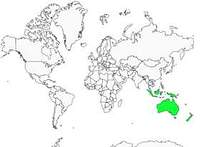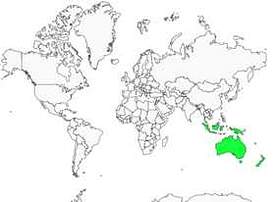Swamp Harrier
Circus approximans - Busard de Gould
Identification
Females are larger than males. Adults have a light grey head, cheek, nape and hood. The upperparts all the way to the tail is presents different hues of brown. However the scapulars and the mantle tend toward a rufous-orange colour. The underparts are white with fine brown streaks. The feathers covering the thighs are orange or pale brown. The undertail coverts are grey and slightly barred. The eye is yellow, as are the legs. First-winter juveniles have brown eyes, a dark brown plumage with an obvious white nape. As they get older, the eye and plumage get paler. Some older birds can even appear greyish-white.
Subspecific information monotypic species
Foreign names
- Busard de Gould,
- Aguilucho lagunero del Pacífico,
- tartaranhão-do-pacífico,
- Sumpfweihe,
- mocsári rétihéja,
- Pacifische Bruine Kiekendief,
- Albanella australasiatica,
- australisk kärrhök,
- Australsivhauk,
- kaňa barinná,
- moták tichomořský,
- Australsk Rørhøg,
- australiansuohaukka,
- arpella del Pacífic,
- błotniak moczarowy,
- Болотый лунь,
- Elang-rawa coklat,
- ミナミチュウヒ,
- 沼泽鹞,
- australisk kärrhök,
- 沼澤鷂,
Habitat
The Australasian Harrier is a specialist of open country and sparse vegetation, and is found from sea level to an altitude of 1,200 meters.
Behaviour character trait
All year round, the Australasian Harrier patrols its territory in search of food. It flies over the countryside, circling effortlessly during long hours. It follow air currents, alternating between gliding and beating its wings. It is frequently mobbed by other species, especially the Spur-winged Lapwing which will harass harriers until they turn tail.
Dietfeeding habits
Although it capture most of its prey on the ground, this raptor seems to have developed a knack for capturing birds perched at the top of trees or sometimes even in flight.
In New Zealand, the Australasian Harrier targets mainly aquatic birds that nest on its territory: young Pkkeko (Purple Swamphen) and ducklings pay the highest tribute. Wild Turkey eggs are also a prized delicacy, especially when then are close to hatching. However, the majority of its diet comes from scavenging on sheep carcasses or roadkill - small marsupials, rabbits and hares, hedgehogs or porcupines.Reproduction nesting
The long breeding season starts in June, when pairs patrol their territory together to ward off intruders.
During the warmer days from July to October, both partners carry out acrobatic display flights punctuated by powerful calls. From September, females start building the nest, usually a low platform principally made of fern, manuka and rushes covered by straw, legumes, grasses and leaves. The nest can be built in diverse spots: on the ground in a marsh, in a wetland dominated by rushes, in bracken, in a grassy area, in a young pine plantation or a road verge. It is rarely found on the fork of a branch. Pairs reuse the same sites year after year.The female alone incubates the 1-7 eggs while the male provides her with food for the 31-34 days of incubation. She also feeds the chicks with the preys that the male brings back. When the chicks are old enough both partners hunt and if the male is alone when returning to the nest, he will drop the food in but will not actively feed the chicks. 2-3 weeks later, the young harrier leave the nest and spread out in the nearby vegetation. They will only fly after 45 days, but stay around the nest and call repetedly until one of the adults provides them with food.
Threats - protection
IUCN conservation status
concern
in the Wild
threatened
evaluated
Sources of information
- IOC World Bird List (v15.1), Gill, F and D Donsker (Eds). 2025-12-07.
Other sources of interest
- Accipitriformes
- Aegotheliformes
- Anseriformes
- Apodiformes
- Apterygiformes
- Bucerotiformes
- Caprimulgiformes
- Cariamiformes
- Casuariiformes
- Charadriiformes
- Ciconiiformes
- Coliiformes
- Columbiformes
- Coraciiformes
- Cuculiformes
- Eurypygiformes
- Falconiformes
- Galliformes
- Gaviiformes
- Gruiformes
- Leptosomiformes
- Mesitornithiformes
- Musophagiformes
- Nyctibiiformes
- Opisthocomiformes
- Otidiformes
- Passeriformes
- Pelecaniformes
- Phaethontiformes
- Phoenicopteriformes
- Piciformes
- Podargiformes
- Podicipediformes
- Procellariiformes
- Psittaciformes
- Pterocliformes
- Rheiformes
- Sphenisciformes
- Steatornithiformes
- Strigiformes
- Struthioniformes
- Suliformes
- Tinamiformes
- Trogoniformes


























